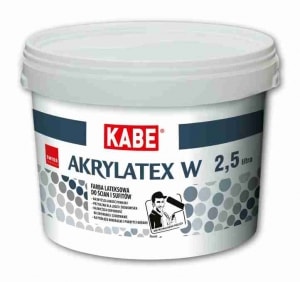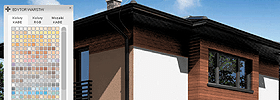AKRYLATEX W

Latex paint for walls and ceilings
A dispersion topcoat paint to be used for protective and decorative coatings inside buildings, both in “dry” and “wet” rooms. Especially recommended for painting walls in rooms with high traffic (such as corridors, staircases) and in wet rooms (such as kitchens, bathrooms and laundry rooms). It can also be used in public utility buildings, health service premises and in food industry production plants (without direct contact with food).
It creates an elastic coating with high tightness and resistance to wet scrubbing as well as the adverse effects of water and the dirt process.It is intended for painting mineral substrates, acrylic plasters, as well as substrates covered by coatings, coats based on polymers and covered with wallpapers made of glass fibres.
Absorbent substrates should be primed with BUDOGRUNT WG or AQUALIT before paint application.
| Base binder: | copolymer binder; |
| Pigments: | titanium dioxide white powder and coloured pigments; |
| The content of volatile organic compounds VOC: | cat. A/a. The product contains less than 30 g/l VOC; |
| Density: | ca. 1,45 g/cm³; |
| Colours: | white and colours from the KABE colour chart and selected NCS colours or according to samples provided; |
| Gloss level: | matt; |
| Diluent: | water; |
| Average coverage: | ca. 0.22 l/m² (with double painting on a smooth substrate); |
| Temperature of application (air and substrate): | from +5°C to +25°C; |
| Relative humidity: | ≤80%; |
| Resistance to wet scrubbing: | paint of class I (per PN-EN 13300 standard) and class I (per PN-C-81914); |
| Relative diffusion resistance of the layer with a thickness of 150 μm: | Sd = 0.9 m (standard requirement Sd ≤ 2.0 m); |
| Surface absorption coefficient: | w = 0.006 kg/m² • h0.5 (standard requirement w ≤ 0.5 kg/m² • h0.5); |
| Packaging: | Single-use plastic packaging of 5 and 10 l; |
| Storage: | The product should be stored in its sealed packaging in a cool, but frost-protected room. Keep out of the reach of children; |
| Shelf life: | 18 months from the production date specified on the packaging of the product with originally closed packaging. |
• High resistance to washing off and wet scrubbing
• Easy to keep clean
• Effective protection against moisture
• Very good coverage and high usage capability
• Wide range of colours
• To be applied on both mineral substrates and polymer coated surfaces
SUBSTRATE PREPARATION: Apply to a sound/stable and clean substrate (without cracks and delaminations), degreased, dry, and free of biological contamination or chemical efflorescence. In the case of fungal growth, the substrate
should be mechanically cleaned and then disinfect with an indoor fungicide. Any loose layers not bound to the substrate (i.e. loose render or flaked coatings) should be removed. Old and/or dirty substrates should be washed off and
degreased with water and CLEANFORCE cleaning agent. If there is any large unevenness of the substrate (from 5 to 15 mm), use levelling compound and then apply the whole surface with PROFINISZ ready-to-use finishing compound.
Minor unevenness (up to 5 mm) can be levelled out at once and smoothened with PROFINISZ ready-to-use finishing compound. Absorbent substrates should be primed with BUDOGRUNT WG before levelling compounds application.
If paint is applied on new mineral substrates (such as concrete, cement plaster, cement-lime plaster), 4-week curing period is required, on gypsum plaster, a minimum of 2 weeks, and on the so-called “Dry construction” immediately after grinding and dust removal.
PRIMING: Prior to paint application the substrate should be primed with BUDOGRUNT WG. Gypsum substrates or non-uniform ones should be primed with AQUALIT. The seasoning period of the agent or primer used on the substrate
before applying the paint is approx. 4 hours. Note: Substrates with low wettability (such as polymer based plasters or dispersion paint coatings) should not be primed, but only washed with water with the addition of CLEANFORCE cleaning agent.
PAINT PREPARATION: If necessary, the paint can be diluted with a small amount of water (adding to the first painting a maximum of 10% by volume, to the second maximum 5%). When determining the amount of water, consider the
following: substrate type, drying conditions and method of application.
APPLICATION: Paint should be applied on the substrate in two layers with a brush, roller or by spraying (including also the ‘airless’ method). Apply the second paint coat only after the first coat has completely dried, after min. 3-4 hours. It is recommended to use a roller made of fleece with a bristle length of 18 mm.
DRYING: Typical drying time of a single layer of paint applied to the substrate lasts approx. 3 h (with temperature +20°C, 55% RH). After painting, closed rooms should be aired until the specific smell disappears. The coating obtains its full mechanical and functional properties after 4 weeks. Note: Drying time may be longer due to low temperatures and high relative humidity.
USEFUL HINTS: To avoid colour differences, a single batch product should be applied to entire facade or element in one working cycle. Application and drying of the paint requires air temperature above +5°C. All tools to be cleaned with water after finishing work. If surfaces of disadvantageous lighting are painted, it is recommended to apply AQUATEX or OPTILATEX or TOP WHITE ANTI -REFLEX deep matt paint.
ADDITIONAL OPTIONS: If paint is applied on substrates covered with scratches up to 0.3 mm wide (such as for example with small cracks of shrinkage plaster), it is recommended to use microfiber reinforced paint for the first time (option available on order). In order to increase the resistance of the paint coating to mould growth, it is recommended to apply a special protective agent to the paint (additional service).


 AKRYLATEX W - TDS
AKRYLATEX W - TDS